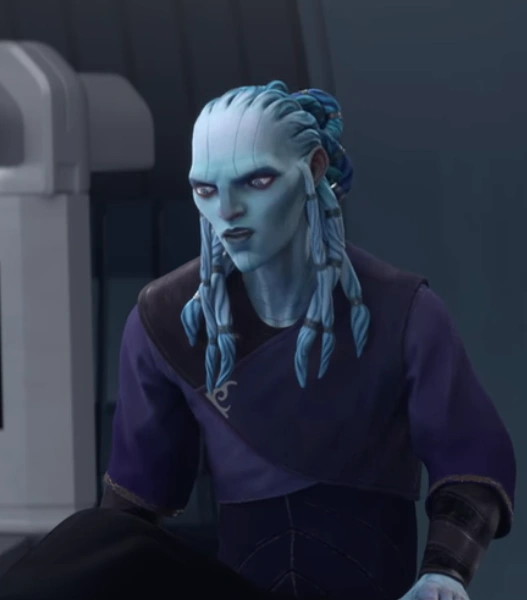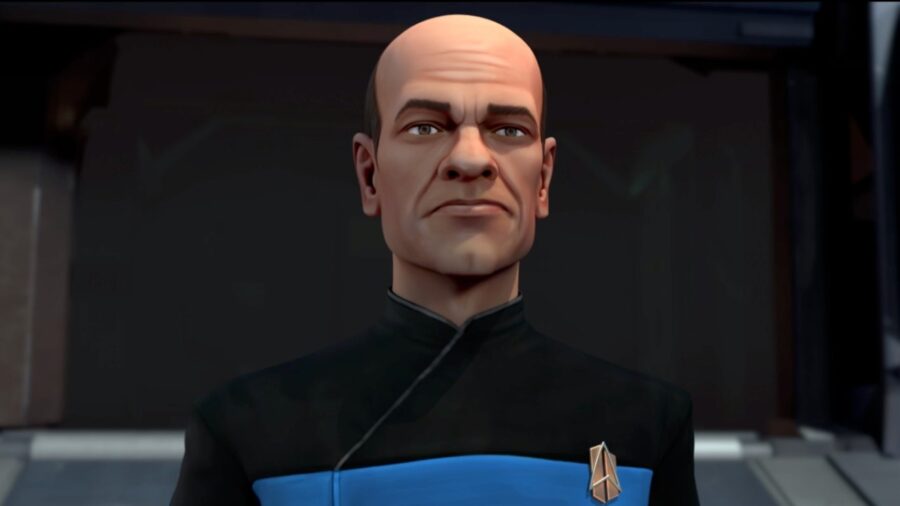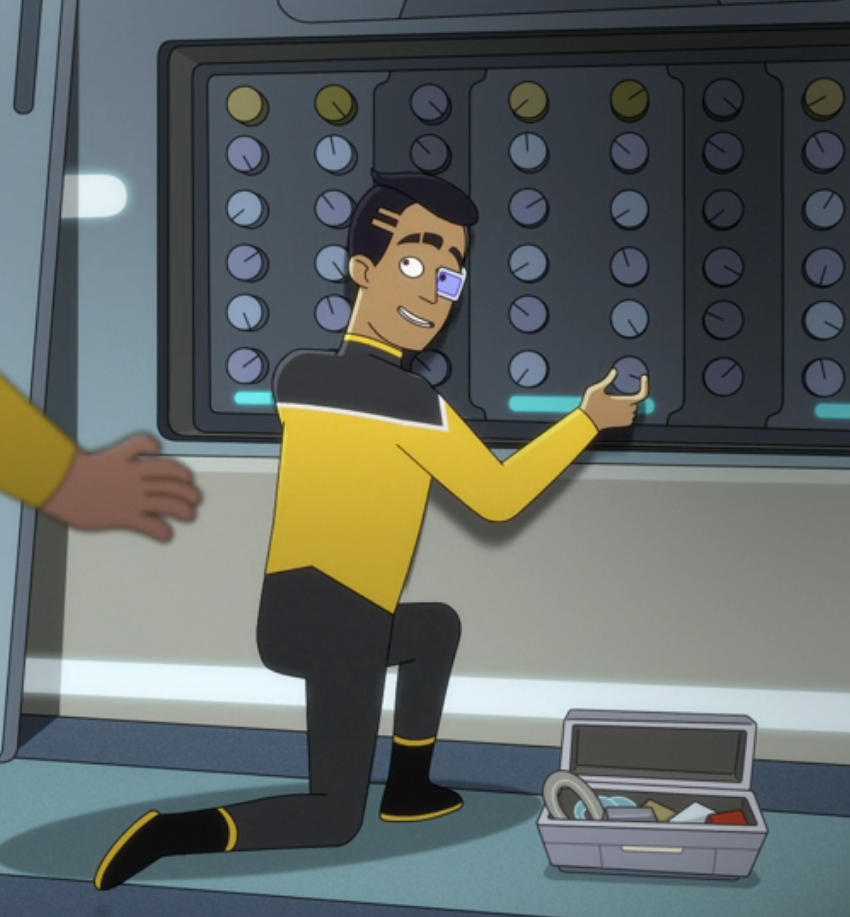The title refers to the titular starbase which is considered the worst posting in Starfleet (LD: “Terminal Provocations”). Mariner herself was posted there after the events of LD: “Trusted Sources”, although she resigned her commission soon after. It was recently mentioned in the season opener LD: “Dos Cerritos”, when it was said that the parallel universe Carol Freeman had been posted there, allowing parallel Mariner to take over Cerritos’s captaincy.
The water planet they just went to is named Piskes IX, continuing the tradition of science fiction planetary names which are just too on the nose, Piscis being Latin for "fish".
Boimler’s beard now has a goatee, although it hasn’t joined with his mustache yet. Boimler talks about “tenth contact”. As we saw back in LD: “Second Contact”, there are follow up missions after First Contact which are dealt with by support ships like Cerritos to formally establish relations, set up infrastructure, etc. for newly contacted civilizations which are called Second Contact missions. “Tenth contact” is likely just Boimler wisecracking rather than a formal mission numbering.
We see the Sequoia shuttlecraft in the background. The shuttle, initially totaled in LD: “No Small Parts” was restored, then taken apart again by T’Lyn in LD: “Shades of Green” so Tendi could work on it together with the others when she returned from Orion. It seems to be coming along nicely.
Cetacean Ops was a throwaway piece of background dialogue in TNG: “Yesterday’s Enterprise” and then elaborated on in the 1992 TNG Technical Manual as well as included on the 1996 Galaxy-class blueprints. The Tech Manual mentioned that Enterprise-D had two whales who helped in navigation. Cerritos’s own Cetacean Ops was mentioned in “Second Contact” and finally seen - the first time Cetacean Ops had been shown on-screen in any Star Trek series - in LD: “First First Contact”. A Cetecean Ops has also appeared in PRO, on the Lamarr-class Voyager-A.
Casperia Prime, a ringed planet, has been mentioned several times in lore as a holiday destination, first in DS9: “Change of Heart” as where Jadzia Dax wanted to honeymoon. In PIC, it was mentioned that Jack Crusher was conceived while Picard and Beverly Crusher were having shore leave on the planet (PIC: “Seventeen Seconds”).
Deep Space 6 is from beta canon, being mentioned in the Last Unicorn RPG and in two VOY novels as well as in Star Trek Online.
The music cues when Starbase 80 appears are reminiscent of horror movie music and are taken from ST II. We can now add Denobulan lice to the blood worms, lemurs and tartan voles native to the planet.
Boimler’s mention of T’Pol is referring to the infamous decon chamber scenes from ENT, where the use of the gel to “decontaminate” after exposure to potentially hostile environments was just a gratuitous excuse to show the crew rubbing each other down while dressed in their underwear (ENT: “Broken Bow”). I’ve never heard Boims call Mariner “Mare-Bear” before, but… ew.
While Tendi scoffs at Mariner’s “curse”, we do have actual examples of people losing their mental acuity after prolonged exposure to an environment. In SNW: “Among the Lotus Eaters”, Pike & Co. lost their memory due to radiation from asteroidal material on Rigel VII. In TOS: “The Cloud Minders”, unprocessed zenite ore emitted a gas which reduced intelligence and heightened emotion, leading to a caste division in Ardanan society.
The dilapidated Starbase 80 corridor, complete with various wall fittings, a ladder and a Jeffries tube (even the font from the “Ward 5” sign), takes cues from the TOS Enterprise corridors for their design. Kassia Nox is dressed in a 22nd Century-era jumpsuit (from ENT), wearing Commander pips. Flux spectrometers were supposed to be used for luminosity studies in TNG: “Cause and Effect”.
Mariner was given the disgusting job of emptying the Cerritos holodeck biofilters in LD: “Moist Vessel” in a bid to get her to transfer off the ship. Tendi geeks out over the TOS wall comms which do indeed date to the 2260s, although then why command staff are dressed in ENT-era jumpsuits instead of TOS-era uniforms is an open question. Also in the fusion reactor room is the dilithium crystal access console seen from TOS Season 2 onwards in Enterprise Engineering (TOS: “Elaan of Troyius”, “Day of the Dove”).
SB80's Operations Center is basically a TOS Constitution-class bridge. The Southern-accented engineer Gene Jakobowski in the ENT-era jumpsuit may be a reference to NX-01 Chief Engineer Trip Tucker, especially when they think he’s initially dead. Tucker died on-screen (albeit in a holographic historical simulation) in VOY: “These are the Voyages”, a move that is heavily criticized in fandom, but was brought back in the novels. Gene is voiced by Stephen Root, who played K'Vada in TNG: "Unification".
The Acamarians first appeared on screen in TNG: “The Vengeance Factor”. Acamar is a real binary star system, also known as Theta Eridani, situated about 165 ly from Sol. One of the shops on SB80’s Promenade is called “Lornak’s”, after an Acamarian clan and another sells "Parthas", an Acamarian vegetable.
The “vintage” dress shop Tendi is at has a number of old Trek costumes and props. Hanging above, we have a red female Operations skant and male Sciences top from TOS, a Command top from DIS Season 2, and a female Command skant from SNW. We also see Pulaski's medical skant from TNG, a TMP-era uniform, a Rubicun III costume (TNG: “Justice”), a TOS Klingon uniform with honor sash, a torn Monster Maroon from the movie era, a field jacket from the same period and Ruk’s top from TOS: “What Are Little Girls Made Of?” We also see a First Contact phaser rifle, a movie-era Security helmet, various TOS tricorders and TNG/VOY PADDs, a TOS communicator, a Mirror Universe dagger, what might be a VISOR display stand, Khan’s necklace pendant from ST II, one of those TNG cylindrical bags, and, significantly, since the vendor claims the uniforms are of dead people, a pile of TOS redshirts. Others have pointed out NX-01 baseball caps, a cap from the Kelvin Timeline dress uniform, Kirk and Spock's mobster hats from TOS: "A Piece of the Action", a TNG-era medical kit, and Admiral Mark Jameson's chair from TNG: "Too Short a Season".
The turbolifts have the twist controls from the TOS era, which made a return in SNW, set in that same period.
This is actually the first time I’ve ever seen these kind of stairs in a Starfleet facility. Mackler and Gorm were in Boimler’s landing party on Targalus IX in LD: “Shades of Green”. Harrison Horseberry’s facial transformation is like that of Geordi in TNG: “Identity Crisis” which was due to exposure to parasites on Tarchennan III. The sickbay is also of TOS vintage right down to the design of the biomonitors.
Kassia reveals she’s El-Aurian, a member of Guinan’s long-lived species, although she’s just 30. She also claims that SB80 doesn’t use combadges, although we saw TNG-era combadges on SB80 personnel in “Trusted Sources” (although in this episode the badges are absent). It is possible, I suppose, that they were non-functional or the system ceased to function between that episode and now.
The Arcade has a machine that uses the large circular light that was part of the Atavachron prop in TOS: “All Our Yesterdays”. The screen of the Ferengi’s Fortune game reminds me of the 80s game Joust, and tucked in back is a game with the Cosmic Koala ("Moist Vessel"). Gene is playing a Galaga/Space Invaders-type game where a Romulan Valdore-class is shooting at Constitution refit-class targets (on the side of the cabinet is a Vastam-class from Star Trek Online). Gene is also wearing Scotty's vest from TNG: "Relics".
A zombie Jet Manhaver is on a Klingon targ kid’s ride.
The officer tearing the door wiring apart is Rutherford’s nemesis/rival Ensign Livik (LD: “I Have No Bones Yet I Must Flee”). Horseberry detects an anaphasic consciousness (Clem) possessing the Cetacean Ops whales (TNG: “Sub Rosa”).
“Scrappy underdogs” is also how Mariner described the Lower Deckers in the very first LD episode “Second Contact”.




